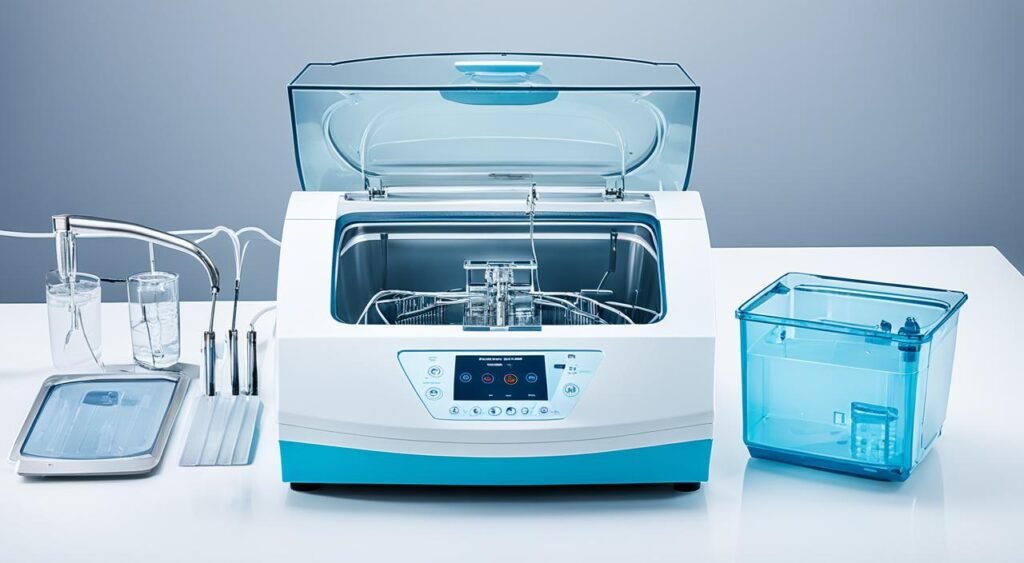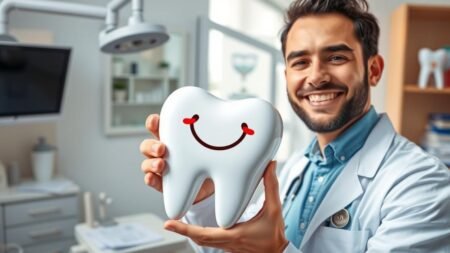Imagine if tools meant to keep professional hygiene promoted germ spread. This shows how crucial dental equipment cleanliness is. Thankfully, the dental ultrasonic cleaner machine boosts safety with its tech. It’s key to fighting germs, making sure your dental office is super clean.
Is there a way to stop germs from sticking to tools during sterilization? Yes, with precision cleaning. Ultra-sonic waves make tiny bubbles that clean tools deeply. They remove blood, saliva, and germs you can’t see.
Now, let’s look at why picking the top dental ultrasonic cleaner is key. It’s not a simple choice. It’s a must for keeping professional hygiene top-notch in dental practices.
Key Takeaways
- Dental ultrasonic cleaners are key for top hygiene.
- High-frequency waves clean deeply, stopping germs.
- Picking a model with a big tank, like the 10L, is crucial for busy dentists.
- These cleaners boost patient safety and tool life.
- A good guide helps in buying, using, and keeping these cleaners.
- Look for efficiency, strength, and quiet when picking a model.
Understanding the Essentials of Ultrasonic Cleaning in Dentistry
In the world of dentistry, ultrasonic cleaning plays a key role in infection control. It begins the process to clean dental tools before sterilization. This step is critical to stop infections from spreading and making sure patients are safe. By using ultrasonic waves, it forms small bubbles to really clean things like scalers and probes.
The benefits of using ultrasonic cleaning are many. It does a better job of cleaning than just using hands. Also, it makes the cleaning process faster, which helps dental offices work more efficiently.
Think about how ultrasonic cleaning can quickly clean tools in just ten minutes. This is very important in places where time is precious. It means more tools can be ready for use, and patients can be seen faster.
| Feature | Benefit |
|---|---|
| Short cleaning cycles | Reduces overall instrument processing time |
| Advanced safety features | Locking lids and cycle validation tools ensure safety and compliance |
| Efficient design in newer models like the Hygea 2 | Monitors critical cleaning parameters for optimal performance |
| Temperature control | Ensures effective cavitation without damaging instruments |
Ultrasonic cleaning is great for all kinds of dental tools. It can clean tools with tricky shapes very well. Tools with joints or small parts are no problem for ultrasonic machines. They clean these tools deeply, which would be hard to do without them.
It’s important to check these machines regularly. The ultrasonic activity should be tested every three months. Also, tests for protein should be done weekly. Changing the cleaning solution when needed helps to keep everything clean and safe for patients.
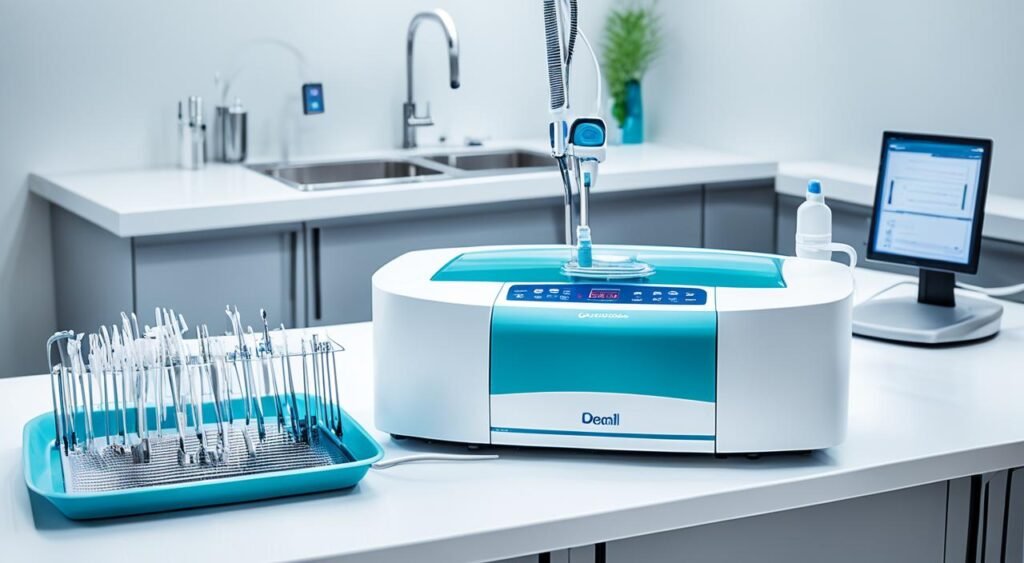
The Role of Dental Ultrasonic Cleaner in Preventing Bioburden Accumulation
A strong dental ultrasonic cleaner system is key in dental clinics. It helps keep patients safe and tools in good shape. It fights off bioburden, which are harmful microorganisms on tools. These germs can cause infections if not dealt with.
What is Bioburden and Why It Matters
Bioburden means there’s bacteria and other stuff on surgery tools. This can be very risky. Ultrasonic cleaners are used to get rid of these germs. They make tools clean so they can be sterilized properly.
Traditional Cleaning vs. Ultrasonic Technology
Old ways of cleaning and new ultrasonic tech are very different. Cleaning by hand might leave stuff behind. Ultrasonic cleaners use sound waves for a deeper clean. This method keeps tools safe and lowers the risk of spreading germs.
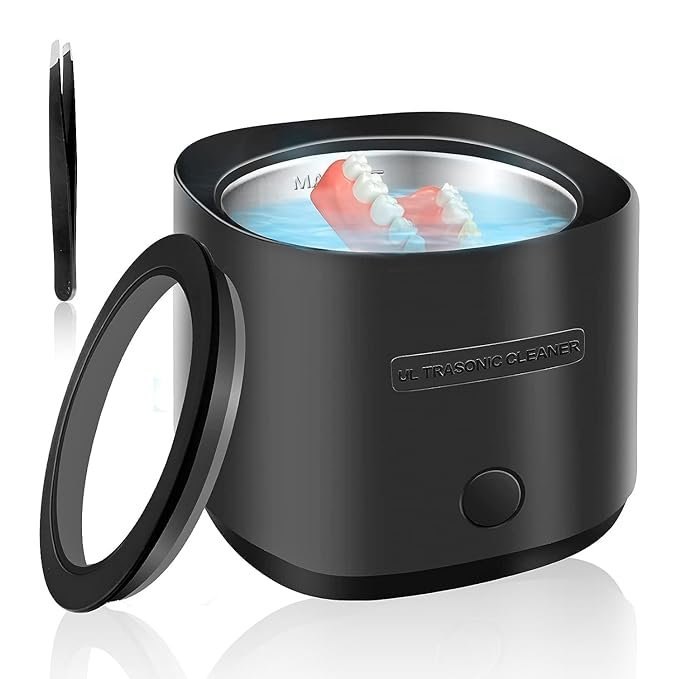
Ultrasonic Retainer Cleaner: 42kHz Portable Sonic Cleaning Pod for Dentures, Mouth Guards, Aligners, and Invisalign
SAY GOODBYE TO ANNOYING NOISE
Using ultrasonic cleaners helps dental places a lot. It gets rid of both big and tiny traces of germs. This careful cleaning stops germs from making tools weaker.
| Product | Price | Volume Produced | Material Compatibility |
|---|---|---|---|
| Pro One SonicTab Ultrasonic Tablets | $49.95 | ¾ gallon | All dental materials |
| EfferZyme Ultrasonic Cleaning Tablets | $53.95 | ½ gallon | All dental materials |
| CrossZyme Enzyme Ultrasonic Cleaner | $37.95 per gallon | N/A | Plastic, glass, aluminum, and stainless steel |
Adding ultrasonic tech to your clinic keeps things clean. It makes tools last longer. By reducing germs, your clinic is safer and works better. This makes patients happy and saves money on replacing tools.
Evaluating the Top Ultrasonic Cleaners for Dental Practices
Looking for the best dental ultrasonic cleaner can be tough. There are many options out there. Yet, consider enzymatic cleaners. They can really boost your dental care. Notable products include Pro One SonicTab Ultrasonic Tablets, EfferZyme Tablets, and CrossZyme Enzyme Ultrasonic Cleaner. These are known for their top performance and modern designs.
Pro One SonicTab Ultrasonic Tablets dissolve fast. They release enzymes that clean and add a nice mint smell. Their pH balance is gentle on dental tools, preventing damage. EfferZyme Tablets clean quickly. This is great for fast-paced dental offices. CrossZyme Enzyme Ultrasonic Cleaner by Crosstex is good for many materials. It fights rust, perfect for places with hard water.
When picking an ultrasonic cleaner, look for one that removes dirt well. It should handle bioburden with its sound waves. Change the cleaning solution daily or when it gets dirty. This keeps your cleaner working well and your tools clean.
| Product | Key Features | Ideal For |
|---|---|---|
| Pro One SonicTab | Quick dissolve, fresh scent, pH balanced | Pre-sterilization cleaning, corrosion-sensitive tools |
| EfferZyme Tablets | Rapid action, easy to use | High patient turnover environments |
| CrossZyme Cleaner | Environmental friendly, rust inhibitor | Diverse materials, hard water areas |
Using EfferZyme and CrossZyme in your dental office leads to better cleaning. This means you don’t have to scrub tools by hand as much. This saves time and energy and keeps your tools in great shape. These solutions break down dirt into water-safe parts that rinse off easily. Remember to change the solutions daily to keep everything clean and safe.
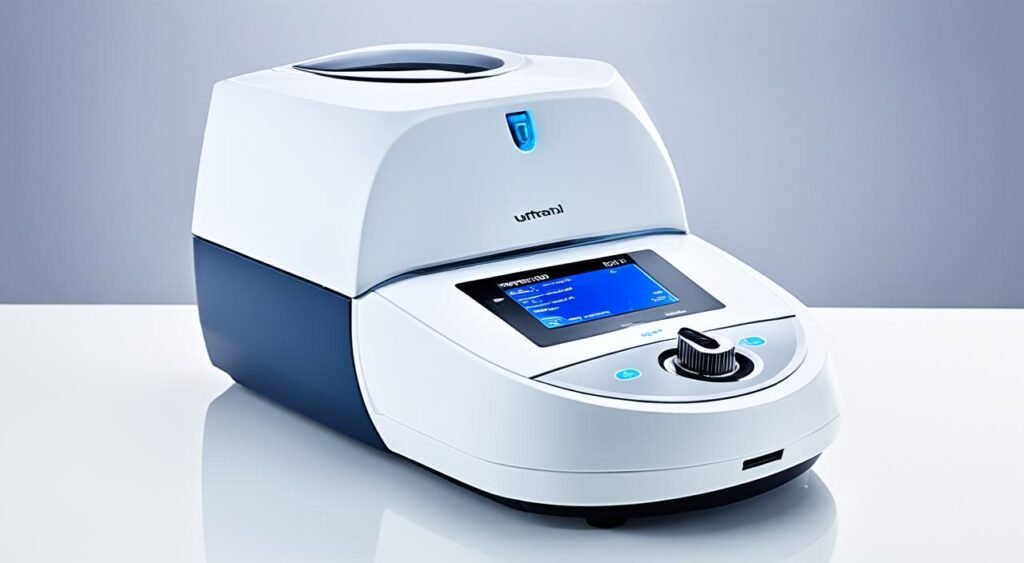
How to Choose the Best Dental Ultrasonic Cleaner Machine
Choosing the best dental ultrasonic cleaner means looking at several important factors. The Zima dental ultrasonic cleaner is great for its effectiveness. The Ivation Ultrasonic Cleaner gives you many options, and the Magnasonic Professional Ultrasonic Cleaner is also very good. It’s crucial to make a choice that matches what your dental practice needs. We’ll break down these options to help you choose wisely.
Factors to Consider Before Purchasing
Think about what instruments you clean the most. Also, consider how many tools you clean every day and the space in your practice. A good ultrasonic cleaner can clean well and make your tools last longer. This makes it a good investment for your practice.
Here are some important things to think about:
- Frequency and Power: Look for machines that clean at about 40,000Hz for the best results. For example, the Ivation Ultrasonic Cleaner works well at this level. It cleans effectively without harming your delicate tools.
- Tank Capacity: Choose the tank size based on how many tools you clean each day. You can find tanks as small as 0.5 liters or as big as 10 liters or more. Larger tanks, like those in the Magnasonic Professional Ultrasonic Cleaner, are good for practices with a lot of tools.
- Ease of Use: Finding a machine with digital timers and automatic shut-off can make things easier. These features add convenience and make the machine more user-friendly.
- Build Quality: Make sure your ultrasonic cleaner is made of durable materials, like stainless steel. This guarantees it can handle daily use and maintain hygiene standards.
Comparing Cost-Effectiveness and Efficiency
When you look at options like the Ivation Ultrasonic Cleaner or the Magnasonic Professional Ultrasonic Cleaner, consider how much they cost versus their benefits. It’s important to find a good balance. This way, you get the best value for your money.
| Brand | Initial Cost | Features | Efficiency |
|---|---|---|---|
| Zima Dental Ultrasonic Cleaner | Medium | Portable, Automatic shutdown | High |
| Ivation Ultrasonic Cleaner | High | Digital timer, Large capacity | Very High |
| Magnasonic Professional Ultrasonic Cleaner | High | Multiple cleaning modes, Extra large tank | Very High |
Choosing a high-quality ultrasonic cleaner can save you a lot of time on cleaning. This means more time to focus on your patients. A good cleaner not only cleans faster but also removes dirt well. This can help your tools last longer and reduce the time you spend cleaning. In the end, it can save money too.LoginPage>
Dental Ultrasonic Cleaner Protocol: Best Practices for Use
Keeping optimal dental tool hygiene is key. Following a robust ultrasonic cleaner user guide helps. It boosts your equipment’s life and performance. Let’s look at key points for top ultrasonic cleaner operation.
- Choose the Right Cleaning Solution: Use the recommended detergent or enzyme-based solution always. It stops residue buildup and keeps a good pH for ultrasonic cleaner maintenance.
- Regular Maintenance Checks: Checking and cleaning the ultrasonic cleaner often is a must. This stops issues and keeps it working well.
- Optimal Filling Practices: Make sure tools are fully covered in solution, not crowded in. The right fill level is crucial for optimal dental tool hygiene.
- Adhere to Cycle Times: Stick to the maker’s cleaning time recommendations. Usually, it’s 3 to 10 minutes, based on how dirty the tools are.
- Use of Warm Water: For units with heating, warm water does a better job. But, don’t make it too hot beyond the unit’s limit.
- Monthly Testing: Test your ultrasonic cleaner once a month at least. The aluminum foil test can check if the waves spread well around the cleaner.
- Proper Instrument Handling: Check tools for dirt and organize them well in cassettes. This cuts the risk of injury during and after cleaning.
- Replace Cleaning Solutions Appropri᠄ate: Change the solution daily or when it looks dirty. This guarantees good cleaning and sterilization.
These steps help your equipment last longer and improve safety and cleanliness. Always remember, ultrasonic cleaner maintenance and proper use keep dental settings clean and safe.
Conclusion
The dedication to achieve optimal hygiene in dental settings is key. It ensures patient satisfaction and keeps safety high. Studies confirm that ultrasonic cleaners are essential in stopping infections. They help keep the surroundings sterile.
A project in nursing homes reduced pneumonia by a lot. It shows how important clean environments are. The American Dental Association also supports the use of ultrasonic technology. They say it’s vital for cleaning dental tools.
As for the elderly and their dental care, using ultrasonic devices is a big win for denture cleanliness. These gadgets are great at removing plaque and other dirty stuff. They not only prove the technology’s worth but also the need for smart cleaning. Devices like the Elmasonic EP60H make cleaning easier and meet strict rules.
Picking the right dental ultrasonic cleaner is more than picking a tool. It shows your care for patients and how good your practice is. Consider the great features of cleaners like the Elmasonic Denta Pro and the options from Elmasonic Select. Using such technology is vital for stopping infections and keeping patients safe. In a field where trust is everything, making sure your tools are as clean as your word is crucial. It’s the top choice for those who want to lead in dental health.
FAQ
Why is a dental ultrasonic cleaner machine essential for professional hygiene?
A dental ultrasonic cleaner is critical for hygiene in dentistry. It uses sound waves to clean equipment deeply. This method easily removes blood and saliva, lowering the chance of passing on germs.
What is the process of ultrasonic cleaning in dentistry and why is it important?
In dentistry, ultrasonic cleaning uses sound waves to clean tools. This process is vital for controlling infections. It makes sure that every tool is safe to use on the next patient.
What is bioburden and how does an ultrasonic cleaner prevent its accumulation?
Bioburden is a buildup of germs on dental tools. An ultrasonic cleaner stops this by cleaning the tools deeply. This reduces infections and keeps the tools lasting longer.
How does ultrasonic technology compare with traditional cleaning methods?
Ultrasonic tech is better than old scrubbing methods. It removes hidden dirt with sound waves. This way, tools are thoroughly cleaned without damage.
What are some of the best dental ultrasonic cleaners on the market?
Great options include Pro One SonicTab Ultrasonic Tablets and CrossZyme Enzyme Cleaner. They clean well and are safe for the environment. These are ideal for keeping tools in top shape.
What factors should I consider when choosing a dental ultrasonic cleaner machine?
Think about what tools you clean and how often. Also, consider if you need special features. The cost and benefits over time are also important to look at.
How does the Zima dental ultrasonic cleaner stand out from others?
The Zima is known for being easy to carry and use. It has an automatic shutoff that’s great for busy dental workers. This makes it a standout choice.
How can I ensure that I am using the dental ultrasonic cleaner correctly?
To use an ultrasonic cleaner right, pick the proper cleaning solution. Do routine upkeep and set it following the manual. Don’t overload it to make sure your tools last.
What are the best practices for maintaining an ultrasonic cleaner?
Clean the tank often and change the cleaning solution as directed. Follow the maker’s advice on maintenance. This keeps the machine working well for a long time.
What are the benefits of using a dental ultrasonic cleaner in my practice?
Using an ultrasonic cleaner boosts your office’s hygiene. It pleases patients and maintains sterilization. It also helps your tools last, creating a better, safer workplace.





